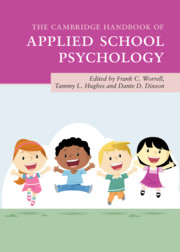Book contents
- The Cambridge Handbook of Applied School Psychology
- The Cambridge Handbook of Applied School Psychology
- Copyright page
- Contents
- Contributors
- Contributor Biographies
- Acknowledgments
- 1 Broadening the Focus of School Psychology Practice
- Part I Individual-Level Academic Interventions
- Part II Teacher- and System-Level Interventions
- Part III Interventions from Educational and Social/Personality Psychology
- Part IV Behavioral and Social-Emotional Interventions
- 19 Internalizing Problems and Disorders of Childhood
- 20 Adolescent Suicidal Behavior in Schools: What to Know and What to Do
- 21 Emotional Disturbance versus Social Maladjustment
- 22 Autism Spectrum Disorder and Illegal Acts
- 23 Effective Bullying Prevention and Intervention Strategies for School Professionals
- 24 Principles of Prevention and Intervention to Close Discipline Gaps in Schools
- 25 Social and Emotional Learning in Schools
- Part V Health and Pediatric Interventions
- Part VI Family Connections and Life Transitions
- Part VII Special Populations
- Part VIII Conclusion
- Index
- References
23 - Effective Bullying Prevention and Intervention Strategies for School Professionals
from Part IV - Behavioral and Social-Emotional Interventions
Published online by Cambridge University Press: 18 September 2020
- The Cambridge Handbook of Applied School Psychology
- The Cambridge Handbook of Applied School Psychology
- Copyright page
- Contents
- Contributors
- Contributor Biographies
- Acknowledgments
- 1 Broadening the Focus of School Psychology Practice
- Part I Individual-Level Academic Interventions
- Part II Teacher- and System-Level Interventions
- Part III Interventions from Educational and Social/Personality Psychology
- Part IV Behavioral and Social-Emotional Interventions
- 19 Internalizing Problems and Disorders of Childhood
- 20 Adolescent Suicidal Behavior in Schools: What to Know and What to Do
- 21 Emotional Disturbance versus Social Maladjustment
- 22 Autism Spectrum Disorder and Illegal Acts
- 23 Effective Bullying Prevention and Intervention Strategies for School Professionals
- 24 Principles of Prevention and Intervention to Close Discipline Gaps in Schools
- 25 Social and Emotional Learning in Schools
- Part V Health and Pediatric Interventions
- Part VI Family Connections and Life Transitions
- Part VII Special Populations
- Part VIII Conclusion
- Index
- References
Summary
In this chapter, we examine the theoretical underpinnings of bullying behavior and link bullying to related but distinct forms of aggression. Bullying prevention and intervention strategies are reviewed and the connection between school climate and bullying is reinforced. Prevention and intervention programs that address improving the school climate are necessary but insufficient to effectively reduce bullying. Given that bullying and targeted violence are typically seen as distinct behaviors, the authors suggest that promoting a holistic violence prevention model should replace the individual and often independent approaches for dealing with various forms of aggression and violence. Instead, a comprehensive and coordinated system of assessment, prevention, and intervention will lead to reductions in bullying and other forms of targeted violence. This will require students, teachers, parents, and community stakeholders (i.e., law enforcement, community leaders, politicians) to work together for the holistic health of schools and communities.
- Type
- Chapter
- Information
- The Cambridge Handbook of Applied School Psychology , pp. 388 - 408Publisher: Cambridge University PressPrint publication year: 2020



